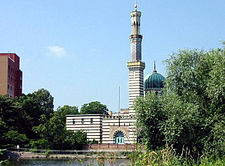- Ruinenberg
-
From the north side of Sanssouci Palace in Potsdam, between the columns, one can see the colonnade of the court of the Ruinenberg on the other side.
In 1748, Frederick the Great had a tank with a capacity of around 7600 m³ built on lands previously used for partridge and pheasant hunts. Master Builder Georg Wenzeslaus von Knobelsdorff and Theater Painter Innocente Bellavite designed blinds of imitation antique ruins. A Monopteros (round temple), three high ionic columns, a small pyramid, and a ruined wall, designed as if from a Roman theatre, were grouped around the pool.
Frederick wanted a lot of water for his then planned projects: a fountain complex, the Neptune Grotto, and a marble colonnade in Sanssouci Park, which is no longer standing. The plans intended to draw water from the Havel with windmills into the high basin on the mountain. It then flowed under the park through a tubular system of hollowed tree trunks, which was to bring the water up into the fountains.
Though the king poured a great deal of money into the project, it yielded no success because of the technical ignorance of his men. After many years of effort, Frederick’s dream of fountains was finally given up in 1780. In a letter to Voltaire, he wrote in 1778:
- I wanted to have a water jet in my garden: Euler calculated the force of the wheels necessary to raise the water to a reservoir, from where it should fall back through channels, finally spurting out in Sans Souci. My mill was carried out geometrically and could not raise a mouthful of water closer than fifty paces to the reservoir. Vanity of vanities! Vanity of geometry!
Around a century after the construction of Sanssouci, Friedrich Wilhelm IV realized Frederick’s dream. Through new technical possibilities of the steam engine and a modern piping system, the fountains were put into place. A building was erected especially for the steam engine (August Borsig) and its pump machine from 1841 to 1843 on the shore of the Havel. Disguised as a mosque, it was designed by Ludwig Persius.
Persius also had plans to extend the theater wall on the Ruinenberg with a 23 m high look-out tower, in imitation of a medieval watchtower. After his early death, the so-called Norman Tower was built by Ferdinand von Arnim in 1846.
References
- The information in this article is based on a translation of its German equivalent.
External links
- The Ruinenberg, the Nordic Garden and Sicilian Garden, and the Potentestück
- The Steam Engine Building
- (German) The Norman Tower
- Potsdam from Above - Ruinenberg
Coordinates: 52°24′35.50″N 13°02′16.60″E / 52.409861°N 13.037944°E
Categories:- Geography of Potsdam
- Buildings and structures in Potsdam
- Brandenburg building and structure stubs
Wikimedia Foundation. 2010.

